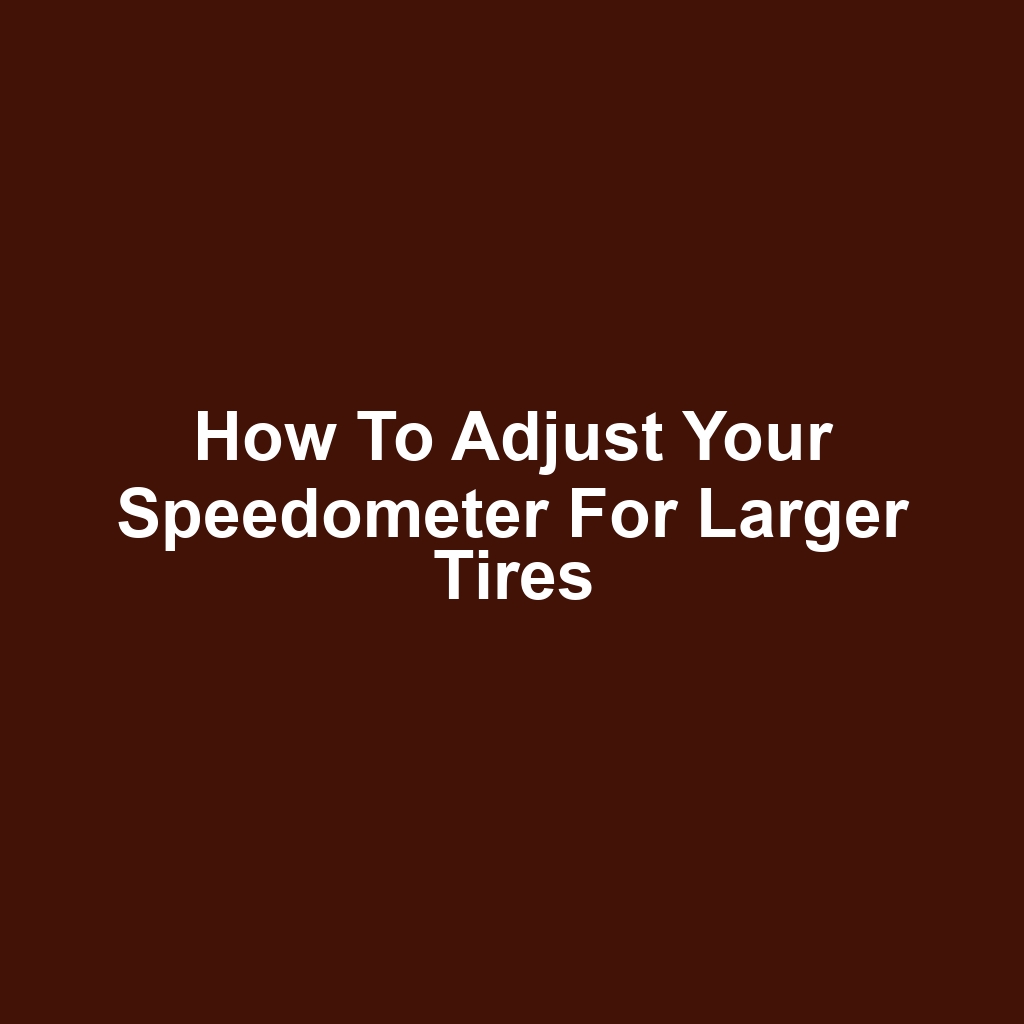When we decide to upgrade our vehicles with larger tires, it’s important to remember that our speedometers might not reflect our true speed anymore. We’ve all been there, wondering how to calibrate speedometer with bigger tires to ensure accuracy while driving. Fortunately, adjusting our speedometer isn’t as daunting as it sounds; with the right tools and a bit of know-how, we can tackle this task ourselves. In this article, we’ll walk through the steps together, from understanding the impact of tire size to testing our adjustments. Let’s dive in and get our speedometers back on track!
Key Takeaways
Accurate calibration is essential to prevent speeding violations caused by larger tires affecting speedometer readings.
Gather necessary tools, including a speedometer calibrator and a tape measure, before starting the calibration process.
Conduct a test drive to verify the accuracy of the speedometer adjustments against GPS data.
Troubleshoot common issues such as calibration errors or wiring problems if speedometer readings remain inaccurate.
Tools and Equipment Needed
We’ll need a few essential tools and equipment to adjust our speedometer for larger tires. First, we’ll want a jack to lift our vehicle safely. A lug wrench will be necessary for removing the wheels. We’ll also need a tape measure to determine the new tire size accurately. It’s important to have a speedometer calibrator or programmer on hand. A socket set will help us access the speedometer sensor easily. Don’t forget to have a pen and notebook ready for taking notes. We might also need a level to ensure our vehicle is stable during the adjustment. Finally, having a friend to help us can make the process smoother.
Understanding Tire Size Impact
The impact of larger tires on our speedometer readings can lead to inaccurate speed calculations if adjustments aren’t made. We’re often unaware of how much our speedometer can be thrown off by just a slight change in tire size. When we switch to bigger tires, our vehicle travels further with each rotation. This means our speedometer can display a lower speed than we’re actually going. If we don’t recalibrate, we might find ourselves speeding without realizing it.
It’s important for us to understand the mathematical relationship between tire size and speedometer readings. We’re also at risk of miscalculating mileage, which can affect our vehicle’s overall performance. By adjusting our speedometer, we’re ensuring our driving experience remains safe and accurate. Ultimately, making these adjustments keeps us informed and helps us avoid potential legal issues.
Step-by-Step Calibration Process
Adjusting our speedometer requires a careful step-by-step calibration process to ensure accuracy with larger tires. First, we’ll gather the necessary tools, including a digital speedometer calibrator. Next, we’ll measure the actual tire diameter to compare with the factory specifications. After that, we’ll input the new tire size into the calibrator. Then, we’ll follow the calibrator’s instructions to start the calibration process. Once we’ve completed the initial setup, we’ll take the vehicle for a test drive to verify the speedometer readings. If the readings are still off, we’ll repeat the calibration steps as needed. Finally, we’ll ensure everything is securely in place before calling it a day. With these adjustments, we’ll be ready to hit the road accurately.
Testing Your Adjustments
Testing our adjustments is crucial to ensure the speedometer accurately reflects our new tire size. We should start by taking our vehicle for a test drive on a flat, straight road. We’ll monitor the speedometer while comparing it to a GPS speed reading. If we notice discrepancies, it’s time to make further adjustments. It’s important we drive at various speeds to gauge accuracy across the range. We’ll also want to note any changes in performance or handling. If everything checks out, we can feel confident in our modifications. Don’t forget to keep track of our findings for future reference. Finally, we can enjoy our upgraded ride knowing the speedometer is calibrated correctly.
Common Issues and Troubleshooting Tips
Common issues we’ve encountered include inaccurate readings and failure to recalibrate properly. We’ve seen many instances where the speedometer still displays the wrong speed after adjustments. It’s important to double-check the calibration process we used. Sometimes, we forget to account for the difference in tire circumference. We’ve also noticed that some vehicles may require additional tools for precise adjustments. If the speedometer needle jumps erratically, it might indicate a faulty connection or wiring issue. We’ve had success by rechecking all connections and securing loose wires. Another problem we’ve faced is the software not updating correctly in digital speedometers. When all else fails, we’ve found that consulting with professionals can save us time and frustration.
Conclusion
In summary, adjusting our speedometer for larger tires is essential for maintaining accurate readings and safe driving. By following the outlined steps and using the right tools, we can ensure our vehicle performs optimally and stays compliant with speed regulations. Testing our adjustments with GPS helps confirm that everything is calibrated correctly. If we encounter any issues during the process, it’s wise to revisit our measurements or seek professional help if needed. Ultimately, taking these steps not only enhances our driving experience but also contributes to our overall safety on the road.
If you’re looking to deepen your understanding of your vehicle’s performance, I highly recommend checking out this insightful article on how to tell if your Silverado has DFM. It provides valuable information that can enhance your driving experience and ensure your truck is running efficiently. Don’t miss out—Continue Reading!
